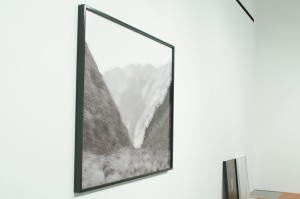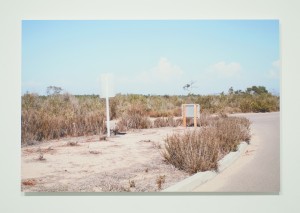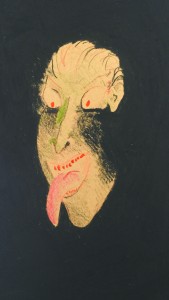Sixteen graduating master of fine arts students will transform the blank white walls and open spaces of the New Wight Gallery at the Broad Art Center with pieces ranging from photography, to drawings, to static objects and models.
Split into four separate showcases featuring four artists at a time, the MFA Exhibition series will open Thursday and continue until May 8, serving as a major portion of the graduate students’ theses.
Professor Hirsch Perlman, chair of UCLA Department of Art, said the MFA Exhibition No. 1 showcases representative collections of the work the artists have created throughout their two to three years in the master of fine arts program. Perlman said his role leading up to the galleries, and the role of the faculty advisers of the program, has been to bring meaning out of the metaphors and allegories in the artists’ works in progress.
“The overall goal of the program – you might think that it was for (the students) to leave with a particular style to their art,” Perlman said. “But actually, I think it’s more about them getting to know themselves really well as creative people in the studio and their creative process.”
The first to present their work at Thursday’s MFA Exhibition No. 1 are graduate students Audra Wist, CJ Heyliger, Calvin Marcus and Elizabeth Conn-Hollyn.
CJ Heyliger | Photography
As a native of Boston, CJ Heyliger was fascinated by California’s dry lakes when he first came to study at UCLA. This interest, Heyliger said, is evident in his 14-photo series for the exhibition “El Mirage,“ named for one particular dry lake located two hours from campus.

At one point, Heyliger said he was visiting the lake almost weekly.
“There’s just something about (El Mirage Lake) that has a lot of gravity and kept me coming back,” Heyliger said. “I kind of think of it as my studio, in a way.”
For his pieces, Heyliger said he photographed the landscapes, developed the images and returned to the same spot weeks or months later, attempting, solely from memory, to line up the exact same shot again and make another exposure on the same piece of film.
Heyliger said his photo series is a study of perception and seeing. His process of repeatedly photographing the landscape as well as the images that came out of it are meant to bring up philosophical questions of rediscovering a single place repeatedly.
In creating “El Mirage” and in his body of work as a landscape photographer, Heyliger said one of his greatest difficulties has been finding newness in previously discovered areas.
“Southern California has been so exhaustibly photographed,” Heyliger said. “It’s been an interesting challenge of how to interpret space in a landscape that is already so well-represented for so many people.”
Elizabeth Conn-Hollyn | Photography
Elizabeth Conn-Hollyn said the turning point for her photography was working at Time magazine in New York after graduating from Bard College. She said that while she had previously focused on making conceptual fine art photography, Time inspired a more sociopolitical slant to her work.

“It made me a lot more aware of how art photography could incorporate political or social documentary aspects to it,” Conn-Hollyn said.
Conn-Hollyn said her showcase for the MFA Exhibition reflects this shift in her photographic and artistic style. Specifically, the subject of her exhibit – which features a video, Google Earth imagery and a sculpture, in addition to her photography – is the U.S.-Mexico border.
Conn-Hollyn said it is due to UCLA’s interdisciplinary approach to the graduate art program that she has been able to incorporate a variety of mediums into her exhibition to best represent her work and research on the subject.
“They really don’t try to limit what you want to do here, and that exploration has actually helped me refine for myself what I should be doing,” Conn-Hollyn said.
To continue with her theme of borders and boundaries, Conn-Hollyn said she is working on a new project with Abigail Collins, a graduate student in art, and University of California, Irvine, graduate student Amy Sanchez. Their work, which is being sponsored by a grant from the UC Institute for Research in the Arts, is culminating in a publication surrounding Conn-Hollyn’s research on the U.S.-Mexico border.
“My thesis and the exhibition – they’re part of a larger body of work about borders and boundaries between countries, especially fugitive borders and boundaries,” Conn-Hollyn said. “I’m using the U.S.-Mexico border as a case study for that investigation.”
Calvin Marcus | Painting and drawing
In the past, Calvin Marcus said he has put up solo art shows of his work in his apartment to give his art exposure. The coming exhibition, he said, is more of a collaboration.
Since each of the artists in the master of fine arts program gets to select whom he or she will be sharing his or her exhibition with, he said the most important factor in choosing to present his pieces alongside the work of Wist, Heyliger and Conn-Hollyn, was camaraderie.

“The likelihood that my work and somebody else’s work would make a lot of sense together just because we all go to UCLA is a pretty slim chance,” Marcus said. “I wasn’t so much interested in trying to find the right group of artists as I was in trying to find the right group of people.”
Of Marcus’ overall artistic style, Perlman said the painter’s art is whimsical, and his pieces are sometimes reminiscent of doodles.
For the exhibition, Marcus said he created a series of self-portraitures that are less explicative than much of his previous work. This retracting of his work, Marcus said, was an intentional technique.
“A lot of times, I find myself putting together an exhibition where I’m actually explaining myself too much,” Marcus said. “These paintings are a little less descriptive, so there’s more to look forward to and more to unfold in the next thing I do and the next thing after that.”
Audra Wist | New genres
For her portion of the exhibition, Audra Wist said she used her work as a dominatrix performance artist as one source of inspiration for her series, “Model Agency.” The pieces in the series, Wist said, are comprised of devices made out of bondage furniture used in adult films in the 1990s and early 2000s.
Wist said although the pieces are about the act of performing, the devices in the exhibit themselves take the form of static, immobile objects.
“(The devices) are very much about performance,” Wist said. “But they’re distinctly without a body or a voice. That was all purposely removed.”
Through “Model Agency,” Wist said she is trying to explore the concepts of power and desire and the way in which people hold power. She said the series also explores the double entendre of the word “model” to mean either a bondage device or a physical model replica.
Wist likened the graduate program for art to a sort of boot camp: The students come in with a set of ideas about what they do and what they’re going for, and then that image gets shattered, broken down and built back up. But Wist said this intense act of throwing everything up in the air has forced her to challenge her own artistic beliefs.
“I think it would be bad if (my professors) came into my studio, looked at what I was doing, and said, ‘Wow, this is really great – you’re done!'” Wist said. “I think I’m less concerned with whether or not people will get (my art), but, ‘Am I asking the right questions?’”
